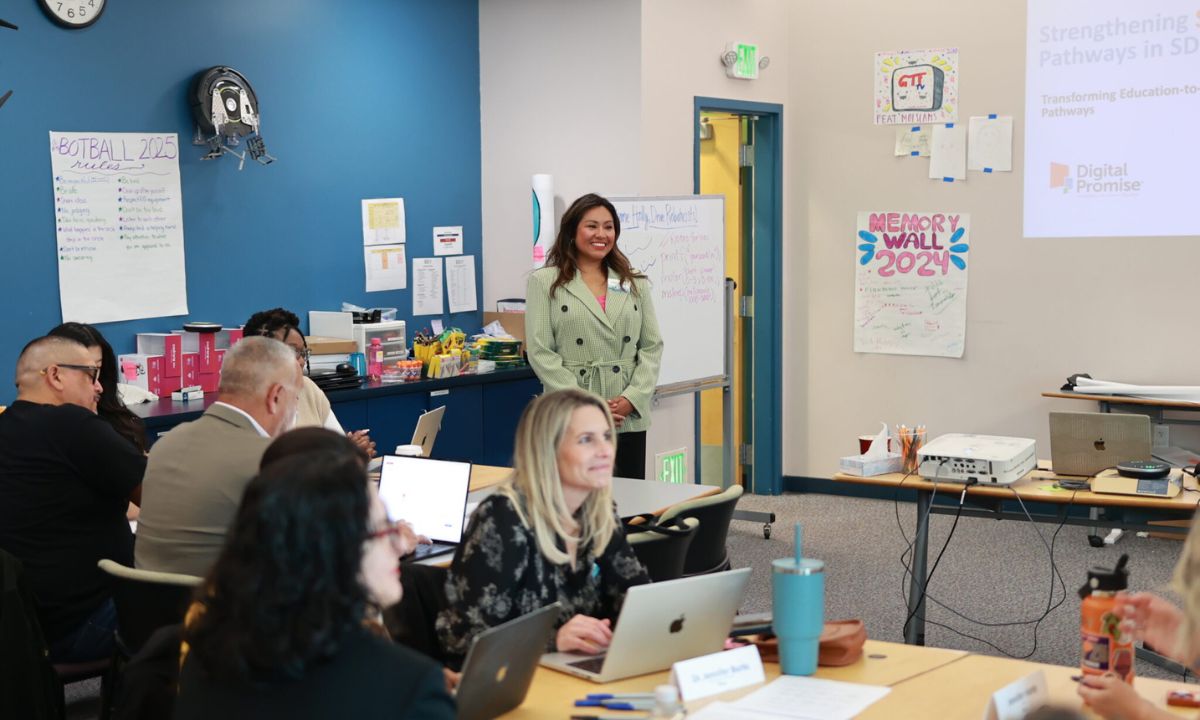Building Sustainable STEM Pathways Requires Trust, Collaboration
When communities feel seen, heard and valued, they become co-architects of change.

Get stories like this delivered straight to your inbox. Sign up for The 74 Newsletter
In sunny San Diego, opportunities in science, technology, engineering and mathematics (STEM) fields are steering the city’s economic growth more than ever before — presenting a future bright with possibilities.
Yet too many students are missing out on opportunities to access the STEM careers that advance the region’s prosperity.
According to San Diego’s 2030 Inclusive Growth Framework, 65% of low-income jobs in San Diego are “predominantly held by people of color.” In the technology, biotech and clean tech sectors, Hispanic and Latino communities are underrepresented, despite the projection that they will constitute nearly half of San Diego County’s future workforce. At the same time, talent scarcity has become a new normal in San Diego.
But we can reverse those trends by investing in cross-sector partnerships and community-driven collaborations to help students access more opportunities in STEM fields.
That’s why we launched the San Diego STEM Pathways initiative, which involves a wide range of community partners working to guide more than 100,000 students toward well-paying STEM careers in San Diego’s high-impact industries. This bold ambition reflects a statewide opportunity to align local innovation with California’s broader economic and impact goals.
To bring everyone together, we engaged different industries through a collaborative design process that ultimately laid the groundwork for our efforts in the region. A 14-member committee of regional leaders representing early childhood education, K-12, postsecondary, workforce development, community-based organizations, and philanthropy reflected on why prior collaborations failed and identified some key factors missing.
To achieve our shared vision of building STEM pathways rooted in community co-design and shaped by the innovation and talent already present in the region, connection, trust and co-creation are essential. Our goal is to build upon existing efforts by fostering alignment across systems, thereby expanding access to opportunities for all students. Achieving meaningful collaboration also requires creating an environment where participants can openly address challenges.
The cross-sector team devoted months to listening, learning and documenting insights. Key emerging themes included the need for:
- Clear communication and a deep understanding of partners’ motivations and aspirations.
- Aligning efforts through early and ongoing conversations with community members, students, industry leaders and local partners to co-design well-rounded STEM pathways.
With support from Digital Promise through dedicated staff to help facilitate the advisory committee and track progress, we have created space to foster relationships and trust. (Digital Promise is a global nonprofit that works with educators, researchers, technology leaders, and communities to design, investigate, and scale up innovations that empower learners.)
Building trust involves planning, consistency and taking actions that contribute to a larger goal. Demonstrating a long-term vision through smaller, incremental actions helps maintain momentum. Given that our advisers are high-level executives, flexibility and a collaborative space where their contributions are valued and not burdensome are crucial for their input to flourish. This requires ongoing nurturing, especially as we move toward a collective regional collaboration.
When communities feel seen, heard and valued, they become co-architects of change. They readily contribute when we engage with them on their terms and at their capacity, rather than expecting them to adapt to our requirements. By accommodating their needs and meeting them where they are — whether they are ready to collaborate, learn, stay informed, or actively participate — we uplift collaborators to become co-creators of change and engage at their desired level.
That’s how we’re building durable systems that truly reflect and serve the needs of all learners across the state of California.
Advisory members began developing their solution concept ideas earlier this year and are now moving toward launching a mini-pilot. Their innovative, community-driven concepts include:
- An effort to support preschool and elementary educators with real-world training that inspires young students in math and science and sets them on a path toward future success through partnerships with local colleges, experts and community partners.
- A program that will work closely with students and families — especially those experiencing housing insecurity — to expand access to STEM through after-school activities, college visits and campus stays that build excitement and readiness for higher education.
- A South Bay initiative that helps students grow their interest and confidence in STEM from middle school through college by combining hands-on learning, career exploration and local partnerships to prepare them for real-world success.
- An easy-to-use online hub where families, educators and partners can find local STEM programs, support services, and ways to work together to create opportunities for all students.
“Building Bridges: Cultivating Interconnectedness for STEM Pathways in San Diego,” a new report produced by the initiative, provides additional information about each of the concept ideas.
As this work continues to gain momentum, the path forward demands deeper engagement with those most impacted — parents, community members and local leaders. But authentic collaboration doesn’t begin with action plans; it begins with trust. As we continue to deepen our partnership, we are constantly reminded that investing in trust-building isn’t a detour from progress; it is progress.
This story was originally published on EdSource.
Get stories like these delivered straight to your inbox. Sign up for The 74 Newsletter

;)